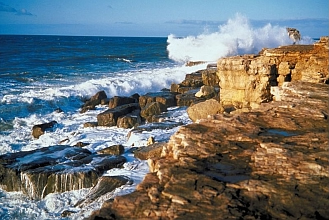Click on image for full size
Image Courtesy of Don Francis, McGill University
Oldest Earth Mantle Reservoir Discovered
The Earth's mantle is a rocky, solid shell that is between the Earth's crust and the outer core, and makes up about 84 percent of the Earth's volume. The mantle is made up of many distinct portions or reservoirs that have different chemical compositions.
Scientists had previously concluded that the Earth was slightly older than 4.5 billion years old, but had not found a piece of the Earth's primitive mantle.
Until recently, researchers generally thought that the Earth and the other planets of the solar system were chondritic. This means that the mantle's chemistry was thought to be similar to that of chondrites, some of the oldest, most primitive objects in the solar system. Chondrites contain certain isotope ratios of the chemical elements of helium, lead and neodymium.
Five years ago a group of scientists from the Carnegie Institution of Washington discovered that the ratio of neodymium on Earth was higher than what would be expected if the Earth was chondritic. That finding changed the amount of neodymium scientists would find in the primitive mantle. It also changed where researchers should be looking to find this primitive mantle. According to the lead author, Matthew Jackson, "We had been looking under the wrong rock."
Since many of the ancient rocks have melted over time, finding a piece of the primitive mantle means studying lavas. Lavas retain the same isotopic composition of the rocks that have melted into the lava. Therefore, testing the lava's composition is identical to testing the original rock's composition.
When the information about neodymium changed, Jackson knew they should take a look at lava samples from Baffin Island, since those samples contained the correct ratios of helium and neodymium.
The researchers studied the composition of the lava found at Baffin Island and discovered that the sample had the correct ratios of all three chemical elements--helium, lead, and the new non-chronditic neodymium ratio. This discovery suggests that the sample from Baffin Island is the first evidence for the oldest mantle reservoir. This discovery will help researchers understand the composition of the original, early Earth.














